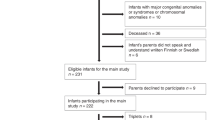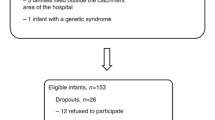Abstract
Objects
Perform neuropsychological screening of a group of preterm twins without major brain pathology and compare it with a control group of similarly preterm children born as singletons.
Materials and methods
Twenty-three preterm twins born at fewer than 32 weeks of gestation were tested for rapid evaluation of cognitive functions at the age of 4 years. The tests evaluated language, non-verbal performances, learning and attention deficit disorders. Cognitive profiles were established. Links between perinatal factors, clinical follow-up and cognitive outcome were investigated. Their cognitive outcome was then compared with the cognitive outcome of 31 preterm singletons with the same gestational periods.
Conclusion
The twins’ neuropsychological outcome was not more marked than that of the singletons. Birth weight discordance and chorionicity were the only predictive perinatal factors with worse outcome in the twin population.

Similar content being viewed by others
References
Adegbite AL, Castille S, Ward S, and al (2004) Neuromorbidity in preterm twins in relation to chorionicity and discordant birth weight. Am J Obstet Gynecol 190:156–163
Alin Akerman B, Fischbein S (1991) Twins: Are they at risk? A longitudinal study of twins and nontwins from birth to 18 years of age. Acta Genet Med Gemellol 40:29–40
American psychiatric association trouble du langage expressif (2003) Manuel diagnostique et statistique des troubles mentaux. In: DSM IV-TR Texte revise. Paris, Masson
Billard C, Livet MO, Motte J et al (2001) BREV: a new clinical scale for the evaluation of cognitive function in school-age and pre-school age children. Arch Pediatr 8(5):545–552
Billard C, Vol S, Livet MO et al (2002) BREV: a rapid clinical scale for cognitive function evaluation in preschool and school-age children. Rev Neurol (Paris) 158(2):167–175
Billard C, Livet MO, Motte J et al (2002) The BREV neuropsychological test: part I. Results from 500 normally developing children. Dev Med Child Neurol 44(6):391–397
Billard C, Motte J, Farmer M et al (2002) The BREV neuropsychological test: part II. Results of validation in children with epilepsy. Dev Med Child Neurol 44(6):398–404
Billard C, Ducot B, Pinton F et al (2006) Validation of BREV: comparison with reference battery in 173 children with learning disorders. Arch Pediatr 13(1)23–31
Brunhes A, Moriette G (2000) Devenir des enfants jumeaux: mortalite et morbidite perinatales. Dans: Pons JC, Charlemaine C, Papiernik E, eds. Les grossesses multiples. Paris pp 219–226
Burguet A, Monnet E, Roth P et al (2000) Neurodevelopmental outcome of premature infants born at less than 33 weeks of gestational age and not cerebral palsy at the age of 5 years. Arch Pediatr 7(4):357–368
Colvin M, McGuire W, Fowlie PW (2004) Neurodevelopmental outcome after preterm birth. BMJ 329:1390–1393
Garitte C, Almodovar JP, Benjamim E et al (2002) Speech in same and different sex twins 4 and 5 years old. Twin Res 5(6):538–543
Glinianaia SV, Pharoah POD, Wright C et al (2002) Fetal or infant death in twin pregnancy: neurodevelopmental consequence for the survivor. Arch Dis Child Fetal Neonatal 86:F9–F15
Larroque B, Marret S, Ancel PY et al and the EPIPAGE study group (2003) White matter damage and intraventricular hemorrhage in very preterm infants: the EPIPAGE study. J Pediatr 143:477–483
Moilanen I, Ebeling H (1998) To be born as a twin risks and sequelae. Int J Circumpolar Health 57:138–147
Msall ME (2005) Neurodevelopmental surveillance in the first 2 years after extremely preterm birth: evidence, challenges and guidelines. Early Hum Dev 82:157–166
Organisation mondiale de la sante (1994) Troubles mentaux et du comportement. Criteres diagnostiques pour la recherche. In: Classification internationale des maladies CIM 10. Dixième révision. Genève:OMS
Palisano R, Rosenbaum P, Walter S et al (1997) Development and reliability of a system to classify gross motor function in children with cerebral palsy. Dev Med Child Neurol 39(4):214–223
Papile LA, Burstein J, Burstein R, Koffler H (1978) Incidence and evolution of subependymal and intraventricular hemorrhage: a study of infants with birth weight less than 1500 gm. J Pediatr 92:529–534
Perlman JM, Rollins N (2000) Surveillance protocol for the detection of intracranial abnormalities in premature neonates. Arch Pediatr Adolesc Med 154:822–826
Salt A, Redshaw M (2006) Neurodevelopmental follow-up after preterm birth: follow-up after two years. Early Hum Dev 82:185–197
Scher AI, Petterson BEV, Blair E et al (2002) The risk of mortality or cerebral palsy in twins a collaborative population based study. Pediatr Res 52:671–681
Tresmontant R (1986) Codage socio culturel. Communication Vl° journées de I’Assoxciation d’Economie Sociale. Lille. Nouvelles technologies et politiques sociales
Usher R, McLean F (1969) Intrauterine growth of live-born Caucasian infants at sea level: standards obtained from measurements in 7 dimensions of infants born between 25 and 44 weeks of gestation. J Pediatr 74:901–910
Author information
Authors and Affiliations
Corresponding author
Rights and permissions
About this article
Cite this article
Einaudi, MA., Busuttil, M., Monnier, AS. et al. Neuropsychological screening of a group of preterm twins: comparison with singletons. Childs Nerv Syst 24, 225–230 (2008). https://doi.org/10.1007/s00381-007-0422-6
Received:
Published:
Issue Date:
DOI: https://doi.org/10.1007/s00381-007-0422-6




